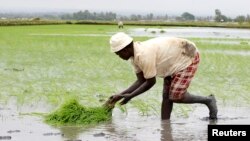A new U.N. report says sub-Saharan African countries have made some progress toward meeting the Millennium Development Goals (MDG), but poverty remains a widespread problem.
At the beginning of this century, U.N. member states unanimously agreed to forge a commitment to help the poorest to achieve a better life by 2015.
The Millennium Declaration articulated a bold vision and established concrete targets for improving the existence of tens of millions of people and for saving the lives of those threatened by disease and hunger.
A new report by the U.N. Development Program notes that persistent obstacles and new challenges may hinder sub-Saharan Africa's ability to meet the 2015 goals on schedule.
It is the only region that has seen the number of people living in extreme poverty rise steadily, from 290 million in 1990 to 414 million in 2010, accounting for more than a third of those worldwide who are destitute.
Across the region, almost half the population lives on less than $1.25 a day.
UNDP economist Wilmot Reeves spoke to VOA about the challenges.
“Some of the challenges that are facing some of the governments in sub-Saharan Africa in terms of MDG's achievements have to do with first, financial resources that are much needed to support some of the interventions related to lagging MDGs,” said Reeves.
But it is not all gloom. There has been important progress across all goals, with some targets already having been met, well ahead of the 2015 deadline.
Steady progress has been made in expanding access to primary education in the region. Between 2000 and 2012, the school enrollment rate increased from 60 to 78 percent.
Women in the region are also gaining more power in politics. The proportion of seats held in single or lower houses increased from 13 percent in 2000 to 23 percent in 2014.
According to Reeves, the post-2015 agenda looks promising, with a more inclusive process in which all stakeholders are involved in setting up the targets.
“The post-2015 development agenda has been able to at least adopt an approach where you have a wider stakeholder participation in the crafting of the post-2015 development agenda,” said Reeves.
In a few months the United Nations will release a specific report on Africa and the Millennium Development Goals.





